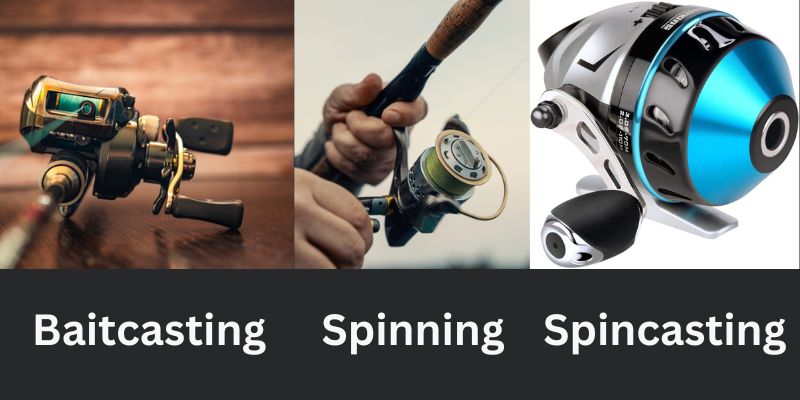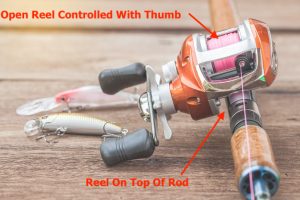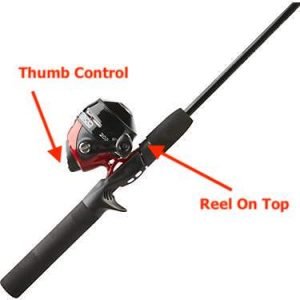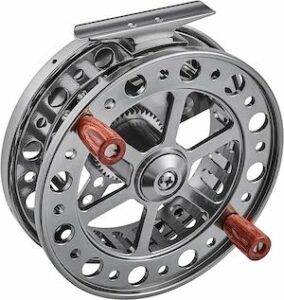Unless you’re practicing a highly specialized type of fishing like tenkara, if you have a fishing rod, you need a reel. And just as there are many types of fishing rods, there are also several types of fishing reels. Today, we’re going to discuss what makes these reels work the way they do, the best type of fishing for each type of reel, and why some reels are easier to use than others.
Fishing reels can be divided into three major categories: Baitcast reels, spincast reels, and spinning reels. We also will highlight an “Other” category
Fishing Reel Types Chart
| Type of Reel | Brief Description | Key Features | Skill Level |
| Baitcasting | A technical reel with a high line capacity, and a steep learning curve; good for heavy lines and lures | Partially housed, strong line control, high line capacity, extra drag control mechanisms | Intermediate-Expert |
| Spincasting | The easiest reel to use, but highly limited in line capacity and casting distance | Completely encased in a housing, uses a button to control line release | Beginner/Casual use |
| Spinning | An all-around reel type with lots of versatility and good casting control | Open construction, uses a metal bail to control line spooling | Beginner-Expert |

Anatomy of a Fishing Reel
Before we talk in detail about the types of reels, we should address some of the terminology used in describing them. These are the key parts of a reel, and will be helpful to know while you’re reel shopping.

- Bail: The bail is a metal arm (usually arc-shaped) that flips open or closed and guides the line onto or off the spool during casting or retrieval. Only spinning reels have a bail.
- Drag Knob: This knob (or dial) is located on the reel frame. It lets you fine-tune the amount of resistance applied by the drag system.
- Drag System: The drag system allows you to apply controlled resistance to the pull of a fish while you’re fighting it. This prevents line breakage and helps tire the fish out gradually. The drag system itself is usually controlled by a lever (lever drag system) or a star-shaped gear (star drag system).
- Frame or Reel Body: The frame or reel body is the main structural component of the reel, housing and supporting all the internal parts. Baitcasting reels have a casing around the frame that hides most of it from view while the reel is in use.
- Gear System: This system transfers power from the handle to the spool. You will see the phrase “gear ratio” used when discussing a reel’s versatility; more on that shortly.
- Handle: This is what you crank when you’re reeling in a fish.
- Line Guide/Line roller: This is a small roller mounted on the bail arm of a spinning reel that helps guide the line and prevent snags during line retrieval.
- Spool: This is the cylinder your line is wrapped around.
What Does Gear Ratio Mean?
A reel’s gear ratio refers to the relationship between the number of revolutions made by the reel’s spool and the number of revolutions made by the handle in a single turn. It tells you about the line retrieval speed. It is represented by a numerical value, such as 6.2:1. The first number is the number of spool revolutions per handle revolution. A gear ratio of 6.2:1 means that the spool will turn 6.2 times for every one time you turn the handle.
- A high gear ratio is around 7.1:1 or higher. This means that the line retrieval is fast.
- A low gear ratio is around 5.4:1 or lower. These reels retrieve line more slowly, but provide more cranking power.
- A versatile or medium gear ratio is around 6.1:1-6.4:1, and can handle a wide range of applications. If you’re new to fishing, look for a mid-level gear ratio, which will be helpful in most situations.
Baitcast Reels

Baitcast reels are beloved by experienced anglers for their accuracy, control, and versatility. You’ll see this type of reel used in both freshwater and saltwater fishing, especially for big fish. These reels can handle heavy lines and lures, and are great for precise casting.
Design
The design of a baitcast reel sees the spool unravel parallel to the rod. Unlike spinning reels, where the spool is fixed and the line is released by the bail, baitcasting reels use a revolving spool that rotates as the line flies during the cast. The line is released by hand, using your thumb to control the spool’s rotation speed.
Baitcast reels are semi-enclosed and have a sturdier build than spinning reels. There are several additional mechanisms attached to this reel, too. Baitcast reels feature a spool tension knob and braking system, and may also feature a thumb lever. The tension knob and braking system let you adjust how fast the line goes out of the reel, while the thumb lever lets you control the spool’s rotation speed. If it doesn’t have a thumb lever, you’ll just put your thumb directly on the line.
The spool rotation does two major things. First, it makes it less likely that the line will tangle as it is retrieved. This does require a bit of a learning curve– as you start to learn this reel, you will likely encounter some tangling. This is called backlash, and it is the most challenging part of using a baitcaster.
Secondly, the rotation increases casting distance. This allows for more control over your casting distance and location, making this a great reel for use in weedy waters or near shorelines.
Casting Tips
One of the key things to learn about casting with this type of reel is learning how to prevent the spool from turning faster than the line is going out. If the spool starts turning faster than the line, you get a snarled tangle known as a bird’s nest.
Since baitcasters don’t have a bail, you will press your thumb against the spool, even if the line is in mid-flight. Once you’ve made your cast and the bait hits the spot, you press a clip to lock the line.
Best Uses
Baitcasting reels are challenging to use; they’re best for fishers with at least intermediate experience. Some of their best uses include:
- Big game fishing
- Crankbait fishing
- Flipping and pitching
- Heavy cover fishing
Pros and Cons of Baitcast Reels
Pros:
- Accurate aiming
- Precise control
- Can handle heavy fishing line and lures
- Lots of power and torque
- Versatile, can be used for lots of different types of fishing
Cons:
- Difficult to master
- Easy to tangle unless you know what you’re doing
- Requires more maintenance than other types of reels
- Often more expensive than other types of reels
See examples of baitcast reels on Amazon
Spincast Reels

Spincast / Casting Rod
Spincast reels are simple and easy to use. Their design is basic, and they are extremely cheap. You can pick up a decent spincast reel for around $20-$30 at many shops.
Design
Spincast reels feature a metal or plastic housing that hides the components of the reel. On the back, there’s a button that switches the reel between locked and freely turning. These reels typically come with a pre-spooled line.
These reels may have a drag adjustment mechanism, although the most inexpensive or basic ones don’t always have one. If it does, the drag mechanism is usually on the side of the reel, next to the handle.
Casting Tips
It’s very easy to cast with a spincast reel. All you need to do is press the button, swing, and release. To stop the line, press the button one more time. It’s not the most precise cast, but it’s easy and doesn’t have much of a learning curve.
Best Uses
Spincast reels can’t handle particularly large or strong fish– they just aren’t robust enough for this type of fishing. If you want to use a spincast reel, here are the best types of fishing for its use:
- Bank or dock fishing
- Light tackle fishing
- Panfish fishing
Pros and Cons of Spincast Reels
Pros:
- Budget friendly
- Easy to use
- Great for beginners
- Reduced line tangling
Cons:
- Limited casting distance
- Limited drag system
- Not the most durable
- Small line capacity
See examples of spincast reels on Amazon
Spinning Reels

Spinning reels might be the most popular type of fishing reel. Their open-face design makes them easy to use and maintain, and they are quite versatile.
Design
Spinning reels have a fixed, open spool. The line is guided onto the spool by the bail arm, which is a curved rod that flips over the spool to secure the line during retrieval. Their drag system applies pressure to the spool to control the resistance as you fight with the fish. They mount underneath your rod, which is a very comfortable position.
The bail design means that these reels are particularly easy to use for both casting and shorter line releases. By releasing the bail, you can hold your line against the rod with a finger and either cast or simply drop the line to the bottom for jigging.
Casting Tips
Casting with a spinning reel requires you to release the bail and press the line against the rod with your index finger. From there, just swing the rod and release about halfway through the motion.
To avoid tangles, reengage the bail. Usually the bail is designed to reengage as soon as you start spinning the handle– but that first spin can cause the line to miss the spool and start a tangle. So to avoid that, just flip the bail back as soon as you cast.
Best Uses
Some of the best uses for spinning reels include:
- Bass fishing
- Casting
- Jigging
- Most freshwater fishing applications
- Trolling
Pros and Cons of Spinning Reels
Pros:
- Versatile, great for many types of fishing
- Work equally well with lure and small bait
- Good casting distance
- Budget-friendly; quality models range from $50-$150
- Smooth drag system
- Lightweight
Cons:
- Limited to light-to-midweight tackle and gear
- Performance drops sharply with heavy lines
- Easy to get tangled lines
- Prone to line twist, which requires good line management
See examples of spinning reels on Amazon
Other Types of Reels
Outside of the four major types of reels, there are also additional specialized types of reels. These reels are typically designed for specific types of fishing.
Baitrunner Reels
This is a type of spinning reel designed for live bait. They have a secondary drag system that allows the line to be released with minimal resistance when a fish takes the bait. This lets the fish grab the bait and swim for a little bit before the angler engages the main drag system to set the hook.
Centerpin Reels

Centerpin Fly Fishing Reel
You’ll often see these reels with their British spelling, centrepin, because they are a popular fly reel on Britain’s chalk streams. This type of reel is almost always exclusively used in fly fishing and allows tight line control and delicate presentations.
Fly Reels
Fly reels are, you guessed it, fly fishing equipment. Similar to centerpin reels, these reels offer good line control. They are often matched to specific fly line lengths and weights.
Surfcasting Reels
Surfcasting reels are designed for long-distance casting from the shore, primarily used in surf fishing. They have huge spools and robust construction to deal with the heavy sinkers and rough water conditions found in surf fishing. These reels are often quite heavy, and can stand up to saltwater, so they’re often quite cumbersome for many other fishing applications.
Trolling Reels
Trolling reels are basically just heavy baitcast reels. They have a greater line capacity and a higher drag pressure. These reels are often used by anglers seeking bigger fish because they frequently have two speeds: a fast speed for bringing in line, and a lower speed for more power while fighting a fish.
The Best Reels for Beginners
Fishing equipment can be expensive. For people who love fishing, it’s an investment into their hobby. But if you’ve never gone fishing before, it can be a challenge to figure out what equipment to get. That being said, budget gear can easily be found online, or at your local stores.
One way to make this choice easier is to ask around at sporting goods stores and bait shops. Some outdoor expos and conventions will let you try out equipment at events and talk to experts about what equipment is right for you. Fishing equipment rentals also exist, although the quality here can vary widely. You can often rent equipment at beaches or on public fishing piers. There are also online rental services for higher quality fishing gear or more specialized equipment, like Rent this Rod for fly fishing equipment.
But even with rentals, you still have to make a choice about what type of gear to rent. So how do these reel types work for beginners?
We’ll start by saying that baitcasters aren’t for beginners. Compared to spinning reels, a baitcast reel is more challenging and has a steeper learning curve. They are awesome to use if you know what you’re doing– so learn about line control and casting techniques, and then come back to this reel.
Spincast reels are often recommended for beginners. They are the easiest type of reel to use– but you sacrifice distance and accuracy for that ease. You will reach the upper limit of what a spincast reel can do very quickly.
Spinning reels are easier to use than baitcast reels. They have more of a learning curve than spincast reels, but they are much more versatile and flexible for different types of fishing. You can go further and catch more types of fish with a spinning reel.
If you’re serious about fishing, a spinning reel is honestly better to learn with than a spincaster. Once you learn about line management and how to cast, you won’t be as limited as you would be with a spincast reel.
Reels for Kids
If you’re teaching a kid how to fish, spincasting reels are almost always the way to go. They require the least amount of technical skill to use, and they’re easier for little hands.
You can often find character-branded fishing poles for kids that use very basic spincast reels. While these kits aren’t always the most durable, they are fun for kids. They’re a great way to gauge a kid’s interest in fishing and are just the right size for their first summer in the boat or on the dock. Once they’re a little older and don’t need as much help with line management, then they can level up to a spinning reel
What’s your favorite type of fishing reel? Whether you’re a weekend warrior who loves the simplicity of a spincaster, or a bassmaster who loves their baitcaster, there’s a fishing reel out there for every type of angler.
Max DesMarais is the founder of hikingandfishing.com. He has a passion for the outdoors and making outdoor education and adventure more accessible. Max is a published author for various outdoor adventure, travel, and marketing websites. He is an experienced hiker, backpacker, fly fisherman, backcountry skier, trail runner, and spends his free time in the outdoors. These adventures allow him to test gear, learn new skills, and experience new places so that he can educate others. Max grew up hiking all around New Hampshire and New England. He became obsessed with the New Hampshire mountains, and the NH 48, where he guided hikes and trail runs in the White Mountains. Since moving out west, Max has continued climbed all of the Colorado 14ers, is always testing gear, learning skills, gaining experience, and building his endurance for outdoor sports. You can read more about his experience here: hikingandfishing/about
